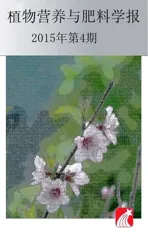施氮量对四川盆地小麦生长及灌浆的影响
2015-06-12李朝苏汤永禄吴晓丽郭大明
李朝苏, 汤永禄 *, 吴 春, 吴晓丽, 黄 钢, 何 刚, 郭大明
(1四川省农业科学院作物研究所, 农业部西南地区小麦生物学与遗传育种重点实验室,四川成都 610066; 2江油市农业局,四川江油 621700)
施氮量对四川盆地小麦生长及灌浆的影响
李朝苏1, 汤永禄1 *, 吴 春1, 吴晓丽1, 黄 钢1, 何 刚2, 郭大明2
(1四川省农业科学院作物研究所, 农业部西南地区小麦生物学与遗传育种重点实验室,四川成都 610066; 2江油市农业局,四川江油 621700)

氮; 小麦; 物质生产; 灌浆特性
小麦是全球最重要的粮食作物之一,受生态条件、生产水平的制约,区域间小麦产量差异极大,虽有小面积单产突破9000 kg/hm2[1-4],但全世界平均单产仅有2800 kg/hm2,我国也不足5000 kg/hm2,即使生产条件较好的区域,大面积单产也仅有6000 kg/hm2左右,和根据各地光温资源估算的产量潜力仍有较大的差距[5-7]。

西南麦区是我国第三大小麦优势产区,常年播种面积210×104hm2,受生态条件所限,生产水平和黄淮、长江中下游等区域有明显差距,有关高产技术探索虽已有30余年,但直至本世纪初才在育种和栽培技术上有所突破,选育出一批以川麦104、川麦42为代表的具超高产潜力的新品种,实产验收屡次突破9000 kg/hm2[4, 10-11]。本研究选择近年通过国家审定、并在长江上游区域有着广泛种植的两个新品种川麦104和内麦836,研究施氮量对其物质生产和灌浆特性的影响,以明确西南地区高产、超高产小麦群体的规律特点,为完善西南地区小麦高产栽培技术提供理论和技术依据。
1 材料和方法
1.1 试验设计
试验采用裂区设计,品种为主区,施氮量为副区,施氮水平分别为0、90、135、180、225 kg/hm2,小区面积12 m2,3次重复。每年的10月30日播种,免耕撬窝点播,行距24 cm,窝距13 cm,每窝播12粒种子,播种后覆盖粉碎的稻草。出苗后匀苗,基本苗保持在220苗/m2左右,2012年内麦836的田间出苗率较低,其各小区基本苗在170苗/m2左右。施氮处理底肥和拔节期追肥比例分别是60%和40%,五氧化二磷和氧化钾用量按75 kg/hm2作底肥施用,氮、 磷、 钾分别由尿素、过磷酸钙和氯化钾提供,施肥时将尿素和氯化钾溶于少量水中浇施,其他时间不再灌溉。在苗期化学除草,孕穗和灌浆期防治蚜虫。
1.2 测定项目及方法
1.2.1 茎蘖变化 匀苗后,每小区沿对角线方向确定3个代表性样点,每点1行连续的5窝,调查基本苗,并于分蘖盛期、拔节始期、开花期和成熟期调查样点内的茎蘖数或穗数,换算群体茎蘖数及穗数。
1.2.2 个体和群体质量 在分蘖盛期、拔节初期、开花期和成熟期,每小区取代表性的4窝植株,将地下部分剪掉,在分蘖盛期和拔节期将植株分为叶片和茎鞘两部分,开花期分为绿叶、黄叶+茎鞘、穗三部分,成熟期分为叶片、茎鞘、穗和籽粒四部分烘干称重,并用干重法测定叶面积。根据各时期调查的群体数量计算群体干物质积累量、叶面积指数,并按照周玲等[12]的方法计算花前干物质转移量、转移物质贡献率等指标,具体计算方法如下:
花前干物质转移量(kg/hm2)=开花期地上部分干物质积累量-成熟期地上部分营养器官干物质量
转移物质贡献率(%)=干物质转移量/籽粒产量×100
1.2.3 产量和穗部农艺结构 各小区收获全部穗,晾晒后用小区脱粒机脱粒并称重,用PM-8188 New型谷物水分测定仪测试称重时的籽粒水分含量。各小区取样损失面积为0.5 m2,根据小区籽粒产量、含水量以及实际收获面积折算13%含水量下的单产和氮素农学利用效率。具体计算方法如下:
产量(kg/hm2)=小区实收产量×(1-籽粒称重时含水量)×10000/[(12-0.5)×0.87]
氮素农学利用效率(kg/kg)=(施氮区籽粒产量-空白区籽粒产量)/施氮量
收获籽粒混合均匀后随机数出两个500粒称重计算千粒重,两份样品重量差数与平均数之比保持在5%以内。在成熟期干物质测定的样本中随机取30个穗调查穗部农艺性状,包括穗长、小穗数、退化小穗数和穗粒数等。
1.2.4 灌浆参数 初花期每个小区标记长势一致且同一天开花的100个穗,在开花7 d后每隔5 d取10穗,将每穗粒剥出,统计数目后烘干称重。采用Logistic方程[W=K/(1+eA+Bx)]对其干物质积累过程进行模拟(决定系数R2均在0.99以上),其中W为观测的籽粒质量,x为开花至观测时的天数,A和B为方程对不同处理确定的参数,K为拟合最大籽粒质量[13]。
对该方程求一阶导数W′,可得籽粒生长速率方程,并可得到以下积累特征参数:
籽粒生长起始势 C0=K/(1+eA);
籽粒最大灌浆速率出现的时间Tmax(d)= -A/B;
最大灌浆速率
Rmax[g/(1000粒·d)]= -KB/4。
灌浆速率曲线的2个拐点:
t1,2=-(A±1.317)/B;
有效灌浆期T0.99K=-(4.59512+A)/B;
渐增期灌浆速率 R1=K/(1+ eA-Bt1)/t1;
快增期灌浆速率 R2= [K/(1+ eA-Bt2)- K/(1+ eA-Bt1)]/(t2-t1);
缓增期灌浆速率 R3= [K/(1+ eA-BT0.99K)- K/(1+ eA-Bt2)]/(T0.99K-t2);
平均灌浆速率R= K/(1+ eA-BT0.99K)/T0.99K。
1.3 数据分析
采用 Excel 2003 和DPS v12.50 软件对数据进行整理、统计分析和作图。
2 结果与分析
2.1 主要性状的联合方差分析
绿汁镇地处河谷地带,道路交通不便,加之山路崎岖,运输核桃只能是小、中型货车,外运成本高,交通运输条件差,导致在收购过程中单价上偏低。
试验产量、产量结构及不同生育期干物质积累量、叶面积指数的联合方差分析结果(表1和表2)表明,施氮水平、品种以及年际间气候条件均对产量及各构成因子有显著的影响,施氮水平对产量的影响大于品种和年份,品种对穗粒数的影响效应大于施氮量和年份,而年份对有效穗数、千粒重、收获指数的影响更大。两因素互作对产量、有效穗数、单位面积粒数和收获指数均无明显影响,但施氮量与品种、品种与年份互作对穗粒数和千粒重有显著或极显著影响。施氮量、品种与年份三者无明显的互作效应(表1)。
施氮水平、品种以及年份对分蘖、拔节期的干物质积累量和叶面积指数有极显著影响,尤其是年份影响效应更大。2012年小麦分蘖阶段雨水充沛,群体数量大,干物质积累量多;而2013年分蘖期降雨较常年明显偏低,分蘖数受影响,干物质积累量也明显低于2012年。虽然施氮量、年份对开花期、成熟期的干物质积累量也有显著影响,但品种间差异已不显著,而且年份的影响也低于分蘖和拔节阶段。除拔节期干物质积累量和叶面积指数具有施氮量和年份互作效应、开花期叶面积指数存在品种与年份互作效应外,其他生育期的干物质积累量和叶面积指数无两者或三者的互作效应(表2)。

表1 产量和产量结构的联合方差分析Table 1 Combined analysis of variances of grain yield and yield components
注(Note): * —P<0.05; ** —P<0.01.
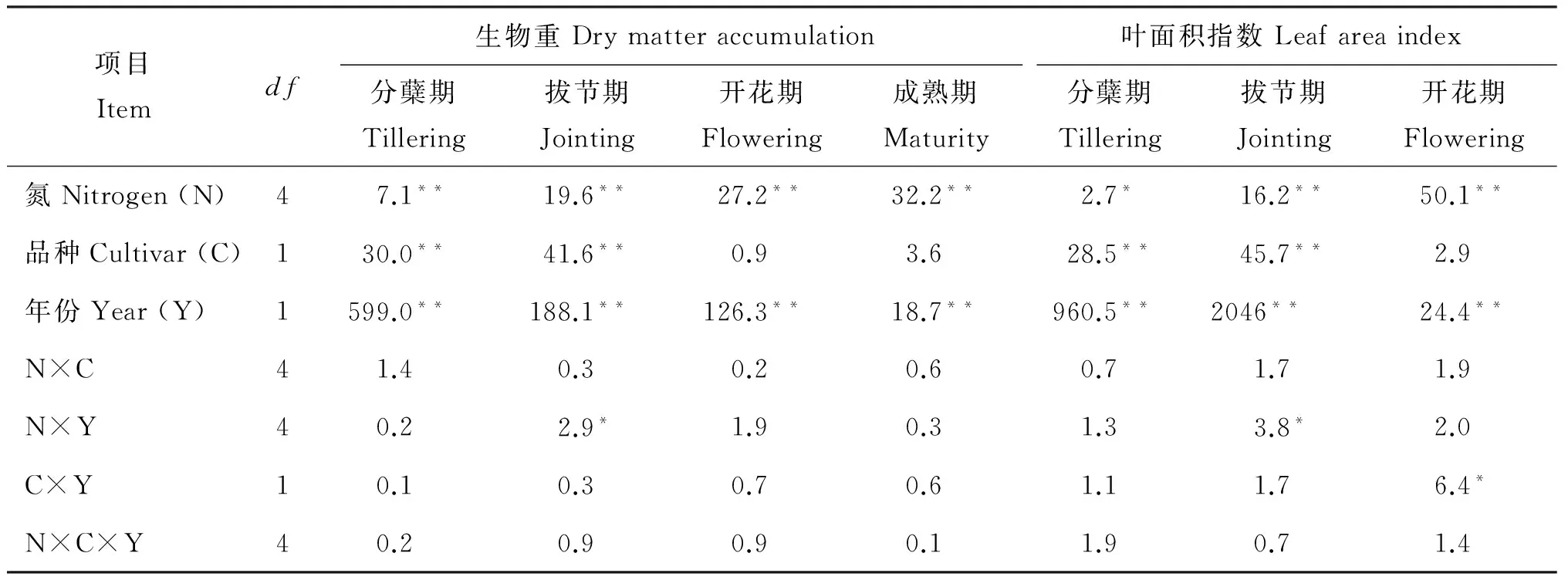
表2 不同生育期干物质积累量和叶面积指数的联合方差分析Table 2 Combined analysis of variances of dry matter accumulation and leaf area index in different growth stages
注(Note): * —P<0.05; ** —P<0.01.
2.2 产量和产量结构
虽然年际间产量和各构成因子有明显变化,但随着施氮量的增加多数参数值均呈上升趋势。同一施氮水平下CM104的产量高于NM836,两个品种均在N 135 kg/hm2处理时产量达到较高水平,与N 180 kg/hm2和N 225 kg/hm2处理差异不显著,且较90 kg/hm2处理有大幅升高。依据两年平均产量(y)和施氮量(x)的关系分别对NM836和CM104建立一元二次方程,其中NM836:y= - 0.0934x2+ 35.991x + 6651.5(P<0.01),最高产量施氮量为192.7 kg/hm2,理论最高产量为10118.7 kg/hm2。川麦104:y= -0.1056x2+ 44.023x + 6724.6(P<0.01),最高产量施氮量为208.4 kg/hm2,理论最高产量为11312.8 kg/hm2。随着施氮量的增加,氮素农学利用效率呈明显下降趋势,NM836的降幅大于CM104。

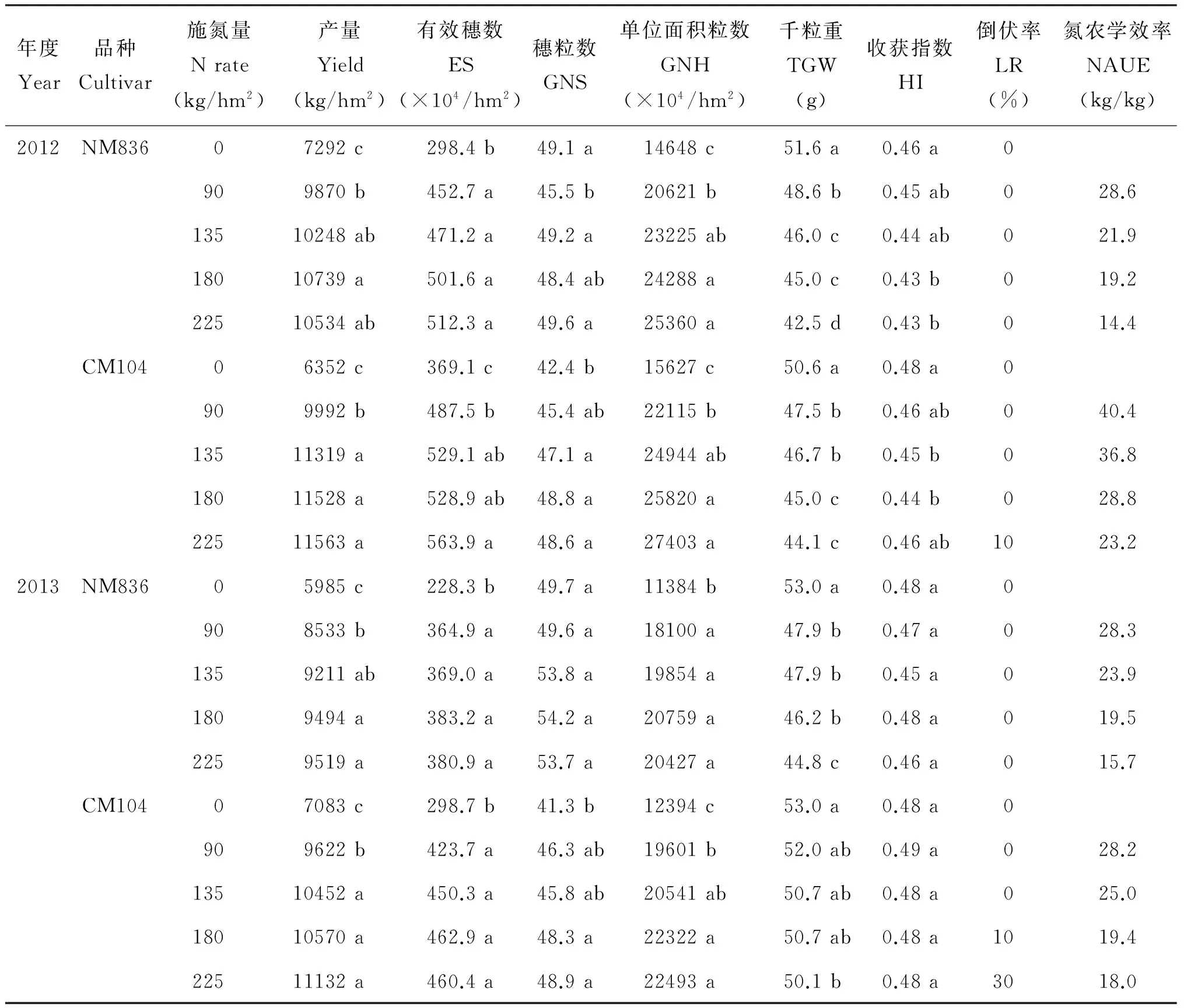
表3 施氮量对不同品种产量、产量结构及氮素农学利用效率的影响Table 3 Effect of the N rates on yield, yield components and nitrogen agricultural utilization efficiency
注(Note): 同列数值后面不同小写字母表示同一年度、同一品种处理间差异达到5%显著水平Values followed by different letters in a column are significant within the same year and cultivar among different treatments at the 5% level; ES—Effective spikes, GNS—Grain numbers per spike, GNH—Grain number per hectare; TGW—1000-grain weight; HI—Harvest index; LR—Lodging ratio; NAUE—Nitrogen agricultural utilization efficiency.
2.3 群体干物质积累量变化


表4 施氮量对不同品种干物质积累量的影响(kg/hm2)Table 4 Effect of the N rates on dry matter accumulation
注(Note): 同列数据后不同小写字母表示同一品种不同处理间差异达到5%显著水平Values followed by different letters in a column are significantly different among different treatments for the same cultivar at 5% level.
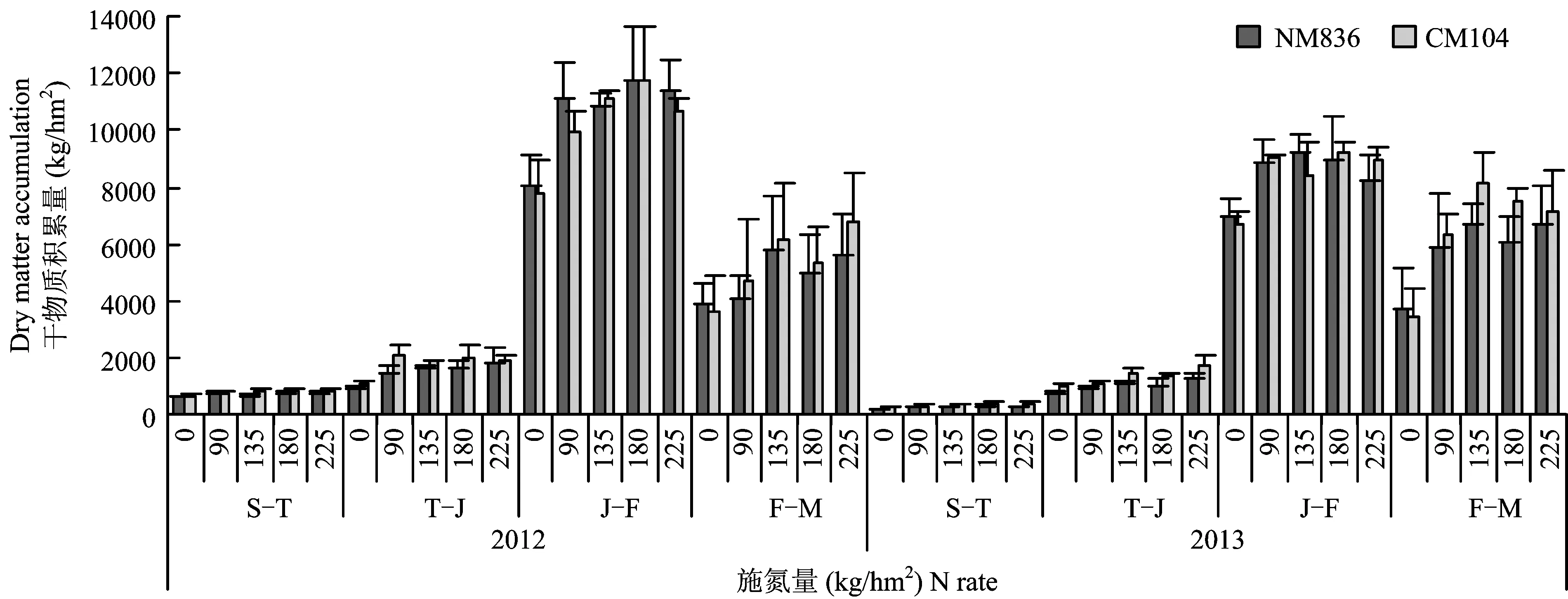
图1 不同生育阶段干物质积累量Fig.1 Dry matter accumulation at different growth stages[注(Note): S-T—播种至分蘖期From seeding to tillering, T-J—分蘖至拔节期 From tillering to jointing; J-F—拔节至开花期From jointing to flowering; F-M—花期至成熟期 From flowering to maturity.]
2.4 不同生育阶段干物质积累量

2.5 开花前物质转移量及转移贡献率
籽粒产量的物质来源一是开花期储存的物质再分配,二是花后光合产物的积累,两个来源对籽粒的贡献因区域、品种、栽培措施不同而异。2012年度,花前干物质积累量大,其在花后转移量也较高,其中N 135 kg/hm2处理处于一个较低水平,而N 90 kg/hm2处理和N 180 kg/hm2处理处于一个较高水平,两个品种转移的量因处理不同互有高低。2013年,开花期干物质积累量相对较少,花后干物质转移量也较少,但和其他处理相比,N 135 kg/hm2处理仍处于一个较低水平, 不施氮处理和N 90 kg/hm2处理处于一个较高水平(图2)。
从转移物质对籽粒的贡献率来看(图3),不施氮处理因籽粒绝对产量低,其花前储存物质对籽粒的贡献率较高,N 90 kg/hm2处理转移量大,其贡献率也较高,而N 135 kg/hm2处理无论品种和年度均处于一个较低水平。除2013年CM104外,N 225 kg/hm2处理的转移物质贡献率也处于一个较低水平。
2.6 对灌浆特性的影响
灌浆特性的相关研究结果表明,千粒重与灌浆速率、灌浆时间均有显著或极显著的相关性,而与灌浆起始势仅有弱的相关性,籽粒初始大小并不是影响籽粒重量的主要因素。
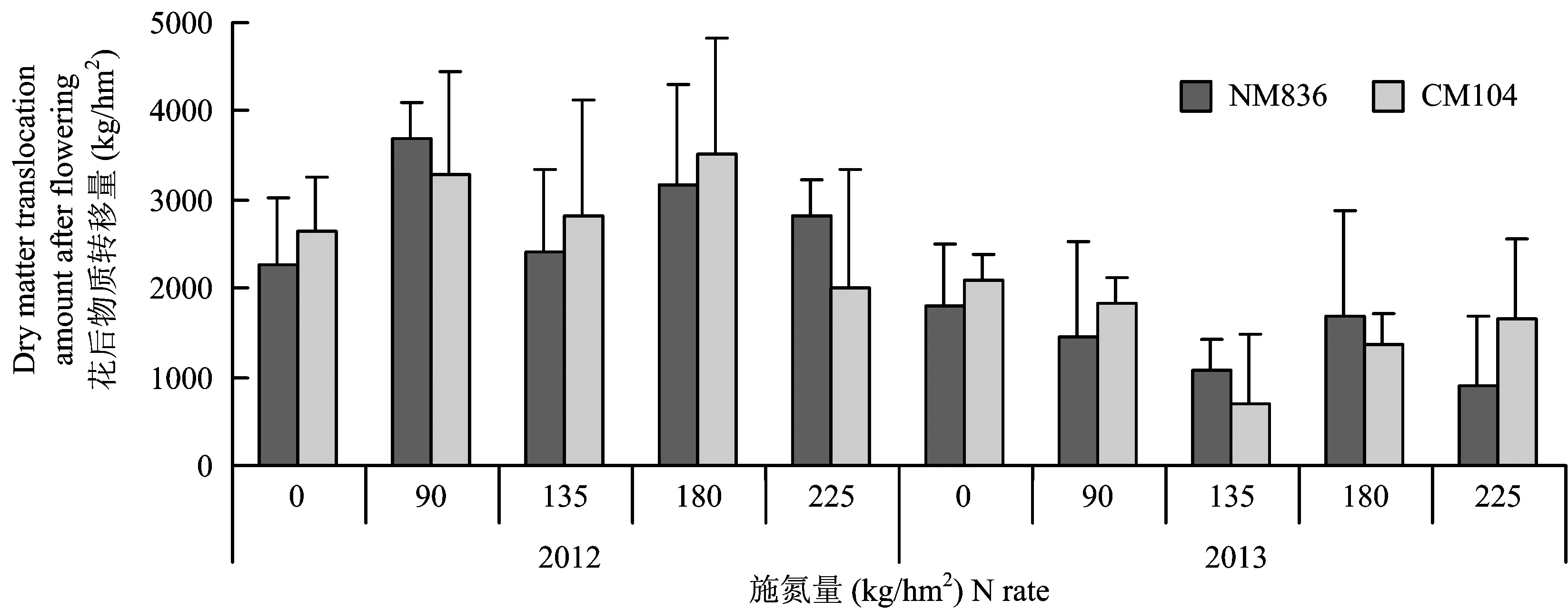
图2 施氮量对花后物质转移量的影响Fig.2 Effect of the N rates on dry matter translocation amount after flowering

图3 施氮量对转移物质贡献率的影响Fig.3 Effect of the N rates on the contribution of remobilization to grain yield
从整穗来看,随着施氮量的增加,平均灌浆速率和渐增期的灌浆速率呈下降趋势(图4)。对于最大灌浆速率,NM836在180 kg/hm2处理时即有大幅下降,而CM104在225 kg/hm2才有大幅下降。施氮对CM104灌浆时间的影响相对较小,但有降低NM836快增期和缓增期的趋势。
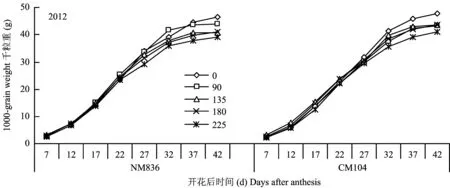
图4 施氮量对籽粒灌浆的影响Fig.4 Effect of the N rates on grain filling of whole spike grains
3 讨论




[1] 丁晓义, 姜鸿明, 陈永娜, 等. 保障我国粮食安全的小麦育种目标探讨[J]. 山东农业科学, 2008, (3): 14-18. Ding X Y, Jiang H M, Chen Y Netal. Research on wheat breeding aims for food safety in China[J]. Shandong Agricultural Sciences, 2008, (3): 14-18.
[2] 于振文, 田奇卓, 潘庆民, 等. 黄淮麦区冬小麦超高产栽培的理论与实践[J]. 作物学报, 2002, 28(5): 577-585. Yu Z W, Tian Q Z, Pan Q Metal. Theory and practice on cultivation of super high yield of winter wheat in the wheat fields of Yellow River and Huaihe River districts[J]. Acta Agronomica Sinica, 2002, 28(5): 577-585.
[3] 丁锦峰, 杨佳凤, 王云翠, 等. 长江中下游稻茬小麦超高产群体干物质积累与分配特性[J]. 麦类作物学报, 2012, 32(6): 1118-1123. Ding J F, Yang J C, Wang Y Cetal. Accumulation and distribution characteristics of dry matter of super high yield wheat under rice stubble in middle and lower reaches of the Yangtse River[J]. Journal of Triticeae Crops, 2012, 32(6): 1118-1123.
[4] 汤永禄, 李朝苏, 吴春, 等. 四川盆地弱光照生态区小麦超高产技术途径分析[J]. 麦类作物学报, 2013, 33(1): 51-59. Tang Y L, Li C S, Wu Cetal. Analysis on the technical measures for super high yield of wheat (9 t·hm-2) in Sichuan Basin with weak light[J]. Journal of Triticeae Crops, 2013, 33(1): 51-59.
[5] 李军, 王立祥, 邵明安, 樊廷录. 黄土高原地区小麦生产潜力模拟研究[J]. 自然资源学报, 2001, 16(2): 161-165. Li J, Wang L X, Shao M A, Fan T L. Simulation of wheat potential productivity on Loess Plateau Region of China[J]. Journal of Natural Resources, 2001, 16(2): 161-165.
[6] 王学强, 贾志宽, 李轶冰. 基于AEZ 模型的河南小麦生产潜力研究[J]. 西北农林科技大学学报(自然科学版), 2008, 36(7): 85-90. Wang X Q, Jia Z K, Li Y B. Evaluations on the productive potential of wheat based on AEZ model in Henan Province[J]. Journal of Northwest A&F University (Natural Science Edition), 2008, 36(7): 85-90.
[7] 王宏, 陈阜, 石全红, 等. 近30 a黄淮海农作区冬小麦单产潜力的影响因素分析[J]. 农业工程学报, 2010, 26(S1): 90-95. Wang H, Chen F, Shi Q Hetal. Analysis of factors on impacting potential productivity of winter wheat in Huanghuaihai agricultural area over 30 years[J]. Transactions of the Chinese Society of Agricultural Engineering, 2010, 26(S1): 90-95.
[8] 郑成岩, 于振文, 马兴华, 等. 高产小麦耗水特性及干物质的积累与分配[J]. 作物学报, 2008, 34(8): 1450-1458. Zheng C Y, Yu Z W, Ma X Hetal. Water consumption characteristic and dry matter accumulation and distribution in high-yielding wheat[J]. Acta Agronomica Sinica, 2008, 34(8): 1450-1458.
[9] 田中伟, 王方瑞, 戴廷波, 等. 小麦品种改良过程中物质积累转运特性与产量的关系[J]. 中国农业科学, 2012, 45(4): 801-808. Tian Z W, Wang F R, Dai T Betal. Characteristics of dry matter accumulation and translocation during the wheat genetic improvement and their relationship to grain yield[J]. Scientia Agricultura Sinica, 2012, 45(4): 801-808.
[10] 汤永禄, 李朝苏, 吴春, 等. 四川盆地单产9000 kg/hm2以上超高产小麦品种产量结构与干物质积累特点[J]. 作物学报, 2014, 40(1): 134-142. Tang Y L, Li C S, Wu Cetal. Yield component and dry matter accumulation in wheat varieties with 9000 kg/ha yield potential in Sichuan Basin[J]. Acta Agronomica Sinica, 2014, 40(1): 134-142.
[11] 李俊, 魏会廷, 杨粟洁, 等. 川麦42 的1BS 染色体臂对小麦主要农艺性状的遗传效应[J]. 作物学报, 2009, 35(12): 2167-2173. Li J, Wei H T, Yang S Jetal. Genetic effects of 1BS chromosome arm on the main agronomic traits in Chuanmai 42[J]. Acta Agronomica Sinica, 2009, 35(12): 2167-2173.
[12] 周玲, 王朝辉, 李富翠, 等. 不同产量水平旱地冬小麦品种干物质累积和转移的差异分析[J]. 生态学报, 2012, 32(13): 4123-4131. Zhou L, Wang C H, Li F Cetal. Analysis of dry matter accumulation and translocation for winter wheat cultivars with different yields on dryland[J]. Acta Ecologica Sinica, 2012, 32(13): 4123-4131.
[13] 孙花, 柴守玺, 刘小娥, 常磊. 不同熟期小麦籽粒灌浆特性的研究[J]. 甘肃农业大学学报, 2009, 44(6): 12-18. Sun H, Chai S X, Liu X E, Chang L. Studies on grain filling characteristics in different maturity type wheat[J]. Journal of Gansu Agricultural University, 2009, 44(6): 12-18.
[14] 于振文, 潘庆民, 姜东, 等. 9000 kg/公顷小麦施氮量与生理特性分析[J]. 作物学报, 2003, 29(1): 37-43. Yu Z W, Pan Q M, Jiang Detal. Analysis of the amount of nitrogen applied and physiological characteristics in wheat of the yield level of 9000 kg per hectare[J]. Acta Agronomica Sinica, 2003, 29(1): 37-43.
[15] 林琪, 侯立白, 韩伟. 不同肥力土壤下施氮量对小麦子粒产量和品质的影响[J]. 植物营养与肥料学报, 2004, 10(6): 561-567. Lin Q, Hou L B, Han W. Effects of nitrogen rates on grain yield and quality of wheat in different soil fertility[J]. Plant Nutrition and Fertilizer Science, 2004, 10(6): 561-567.
[16] 张法全, 王小燕, 于振文, 等. 公顷产10000 kg小麦氮素和干物质积累与分配特性[J]. 作物学报, 2009, 35(6): 1086-1096. Zhang F Q, Wang X Y, Yu Z Wetal. Characteristics of accumulation and distribution of nitrogen and dry matter in wheat at yield level of ten thousand kilograms per hectare[J]. Acta Agronomica Sinica, 2009, 35(6): 1086-1096.
[17] 石祖梁, 顾克军, 杨四军. 氮肥运筹对稻茬小麦干物质、氮素转运及氮素平衡的影响[J]. 麦类作物学报, 2012, 32(6): 1128-1133. Shi Z L, Gu K J, Yang S J. Effect of nitrogen application on translocation of dry matter and nitrogen and nitrogen balance in winter wheat under rice-wheat rotation[J]. Journal of Triticeae Crops, 2012, 32(6): 1128-1133.
[18] 杜世州, 曹承富, 张耀兰, 等. 氮素运筹对淮北地区超高产小麦养分吸收利用的影响[J]. 植物营养与肥料学报, 2011, 17(1): 9-15. Du S Z, Cao C F, Zhang Y Letal. Effects of nitrogen application on nitrogen absorption, utilization in super-high-yielding wheat in Huaibei region[J]. Plant Nutrition and Fertilizer Science, 2011, 17(1): 9-15.
[19] 王月福, 姜东, 于振文, 曹卫星. 高低土壤肥力下小麦基施和追施氮肥的利用效率和增产效应[J]. 作物学报, 2003, 29(4): 491-495. Wang Y F, Jiang D, Yu Z W, Cao W X. Nitrogen use efficiency and yield of wheat with basal and top-dressed nitrogen fertilizers in soils with different fertility[J]. Acta Agronomica Sinica, 2003, 29(4): 491-495.
[20] 高国华. 不同肥力土壤小麦施氮增产效应及氮肥利用率研究[J]. 河南科技学院学报(自然科学版), 2012, 40(3): 11-15. Gao G H. Effect of nitrogen application on yield-increasing and nitrogen use efficiency of wheat in different fertility soils[J]. Journal of Henan Institute of Science and Technology (Natural Sciences Edition), 2012, 40(3): 11-15.
[21] 李向东, 陈源泉, 汤永禄, 等. 集约多熟稻田长期保护性耕作条件下土壤养分变化分析[A]. 高旺盛, 孙占样. 中国农作制度研究进展2008[C]. 沈阳: 辽宁科学技术出版社, 2008. 392-398. Li X D, Chen Y Q, Tang Y Letal. Soil fertility change analysis of intensive multiple-cropping paddy fields with conservation farming system [A]. Gao W S, Sun Z X. Chinese Farming System Research Progress in 2008[C]. Shenyang: Liaoning Science and Technology Press, 2008. 392-398.
[22] 王旭, 李贞宇, 马文奇, 张福锁. 中国主要生态区小麦施肥增产效应分析[J]. 中国农业科学, 2010, 43(12): 2469-2476. Wang X, Li Z Y, Ma W Q, Zhang F S. Effects of fertilization on yield increase of wheat in different agro-ecological regions of China[J]. Scientia Agricultura Sinica, 2010, 43(12): 2469-2476.
[23] 陈安强, 雷宝坤, 鲁耀, 等. 南方山地丘陵区考虑水稻产量和生态安全的容许施氮量[J]. 农业工程学报, 2013, 29(9): 131-139. Chen A Q, Lei B K, Lu Yetal. Study on nitrogen application rate tolerance based on rice yield and ecological security in hilly areas of South China[J]. Transactions of the Chinese Society of Agricultural Engineering, 2013, 29(9): 131-139.
[24] 范明生, 刘学军, 江荣风, 等. 覆盖旱作方式和施氮水平对稻-麦轮作体系生产力和氮素利用的影响[J]. 生态学报, 2004, 24(11): 2591-2596. Fan M S, Liu X J, Jiang R Fetal. Effects of non-flooded mulching cultivation and N rates on productivity and N utilization in rice-wheat cropping systems[J]. Acta Ecologica Sinica, 2004, 24(11): 2591-2596.
[25] 武际, 郭熙盛, 鲁剑巍, 等. 连续秸秆覆盖对土壤无机氮供应特征和作物产量的影响[J]. 中国农业科学, 2012, 45(9): 1741-1749. Wu J, Guo X S, Lu J Wetal. Effects of continuous straw mulching on supply characteristics of soil inorganic nitrogen and crop yields[J]. Scientia Agricultura Sinica, 2012, 45(9): 1741-1749.
[26] 田中伟, 王方瑞, 戴廷波, 等. 小麦品种改良过程中物质积累转运特性与产量的关系[J]. 中国农业科学, 2012, 45(4): 801-808. Tian Z W, Wang F R, Dai T Betal. Characteristics of dry matter accumulation and translocation during the wheat genetic improvement and their relationship to grain yield[J]. Scientia Agricultura Sinica, 2012, 45(4): 801-808.
[27] 汤永禄, 李朝苏, 吴晓丽, 等. 人工合成小麦衍生品种的物质积累、冠层结构及群体光合特性[J]. 中国农业科学, 2014, 47(5): 844-855. Tang Y L, Li C S, Wu X Letal. Accumulation of dry matter, canopy structure and photosynthesis of synthetic hexaploid wheat-derived high-yielding varieties grown in Sichuan Basin, China[J]. Scientia Agricultura Sinica, 2014, 47(5): 844-855.
[28] 张均华, 刘建立, 张佳宝, 等. 施氮量对稻麦干物质转运与氮肥利用的影响[J]. 作物学报, 2010, 36(10): 1736-1742. Zhang J H, Liu J L, Zhang J Betal. Effects of nitrogen application rates on translocation of dry matter and utilization of nitrogen in rice and wheat[J]. Acta Agronomica Sinica, 2010, 36(10): 1736-1742.
[29] 孙旭生, 林琪, 李玲燕, 等. 氮素对超高产小麦生育后期光合特性及产量的影响[J]. 植物营养与肥料学报, 2008, 14(5): 840-844. Sun X S, Lin Q, Li L Yetal. Effects of nitrogen supply on photosynthetic characteristics at later developing stages and yield in super high-yield winter wheat[J]. Plant Nutrition and Fertilizer Science, 2008, 14(5): 840-844.
[30] Gaju O, Allard V, Martre Petal. Nitrogen partitioning and remobilization in relation to leaf senescence, grain yield and grain nitrogen concentration in wheat cultivars[J]. Field Crops Research, 2014, 155: 213-223.
[31] 肖凯, 张荣铣, 钱维朴. 氮素营养对小麦群体光合碳同化作用的影响及其调控机制[J]. 植物营养与肥料学报, 1999, 5(3): 235-243. Xiao K, Zhang R X, Qian W P. The effect and regulating mechanism of nitrogen nutrition on canopy photosynthetic carbon assimilatoin in wheat[J]. Plant Nutrition and Fertilizer Science, 1999, 5(3): 235-243.
[32] 蔡瑞国, 张敏, 戴忠民, 等. 施氮水平对优质小麦旗叶光合特性和子粒生长发育的影响[J]. 植物营养与肥料学报, 2006, 12(1): 49-55. Cai R G, Zhang M, Dai Z Metal. Effects of nitrogen application rate on flag leaf photosynthetic characteristics and grain growth and development of high-quality wheat[J]. Plant Nutrition and Fertilizer Science, 2006, 12(1): 49-55.
Effect of N rate on growth and grain filling of wheat in Sichuan Basin
LI Chao-su1, TANG Yong-lu1*, WU Chun1, WU Xiao-li1, HUANG Gang1, HE Gang2, GUO Da-ming2
(1CropResearchInstitute,SichuanAcademyofAgriculturalSciences/KeyLaboratoryofBiologyandGeneticBreedinginWheat(Southwest),MinistryofAgriculture,Chengdu610066,China;2AgriculturalBureauofJiangyouCity,JiangyouSichuan621700,China)
【Objectives】Nitrogen (N) has a significant effect on the accumulation, transport and distribution of photosynthetic products of wheat. In order to improve wheat yield potential in Sichuan Basin, effects of different N rates on dry matter production and grain filling of high-yield wheat cultivars were studied in Jiangyou City, Sichuan Province from 2011 to 2013. 【Methods】 A randomized block design with a split plot experiment was laid out and two cultivars, CM 104 and NM 836, were used as the main plot factors. Five N rates were set as sub plots: 0, 90, 135, 180 and 225 kg/hm2. Individual and population biomass, yield, yield components and filling parameters of the two cultivars were tested.【Results】 The yield, yield components, dry matter accumulation and leaf area index are all significantly affected by the N rates, cultivars and interannual climatic conditions. In the same N rate, the yield of CM 104 is higher than that of NM836. In the control, the average yield of NM 836 and CM 104 is 6638.9 and 6717.7 kg/hm2. In the N 135 kg/hm2treatment, the yields of two cultivars are more than 9000 kg/hm2and dry matter accumulation is more than 18000 kg/hm2. When the N rate is higher than 135 kg/hm2, the yield and dry matter accumulation increment become less. The relationship of yields and N rates can be described with a quadratic function, for CM104, y=-0.1056x2+44.023x+6724.6 and for NM836, y=-0.0934x2+35.991x+6651.5 (P<0.05). The theoretical maximum yield and the N rate for the highest yield for CM104 are higher than for NM 836. The increased N rates lead to the increment of dry matter accumulation at all the growing stages, but the differences in increment range are not significant from N rate of 135 to 225 kg/hm2and the highest dry matter accumulation after flowering and the contribution of dry matter translocation is in N rate of 135 kg/hm2. Although higher N rate is beneficial for the formation of effective spikes per hectare and grain numbers per spike, especially for the cultivar of CM 104, but not for the grain filling. The maximum grain-filling rate is decreased substantially in N rate of 180 kg/hm2for NM836, 225 kg/hm2for CM104. The 1000-grain weights in all the N treatments are lower than in control, and negative with N application rate increasing.【Conclusions】 The difference in the dry matter accumulation after flowering is the main reason for the different response to N rate for the two cultivars. Appropriate N application rate is very important for achieving high population biomass, increasing the dry matter accumulation and translocation to the grains after flowering. Under the fertile and less N loss paddy soil condition in Sichuan Basin, the suitable N rate for high yield is 135-150 kg/hm2.
nitrogen; wheat; dry matter production; grain filling
2014-06-09 接受日期: 2014-09-10 网络出版日期: 2015-06-01
国家小麦产业技术体系(CARS-3);四川省科技计划项目(2011NZ0098-15);四川省农业科学院优秀论文基金资助。
李朝苏(1980—),男,山东巨野人,副研究员,主要从事作物高产栽培技术研究。Tel: 028-84504560, E-mail: xiaoli1755@163.com * 通信作者 Tel: 028-84504601, E-mail: ttyycc88@163.com
S147. 22
A
1008-505X(2015)04-0873-11
